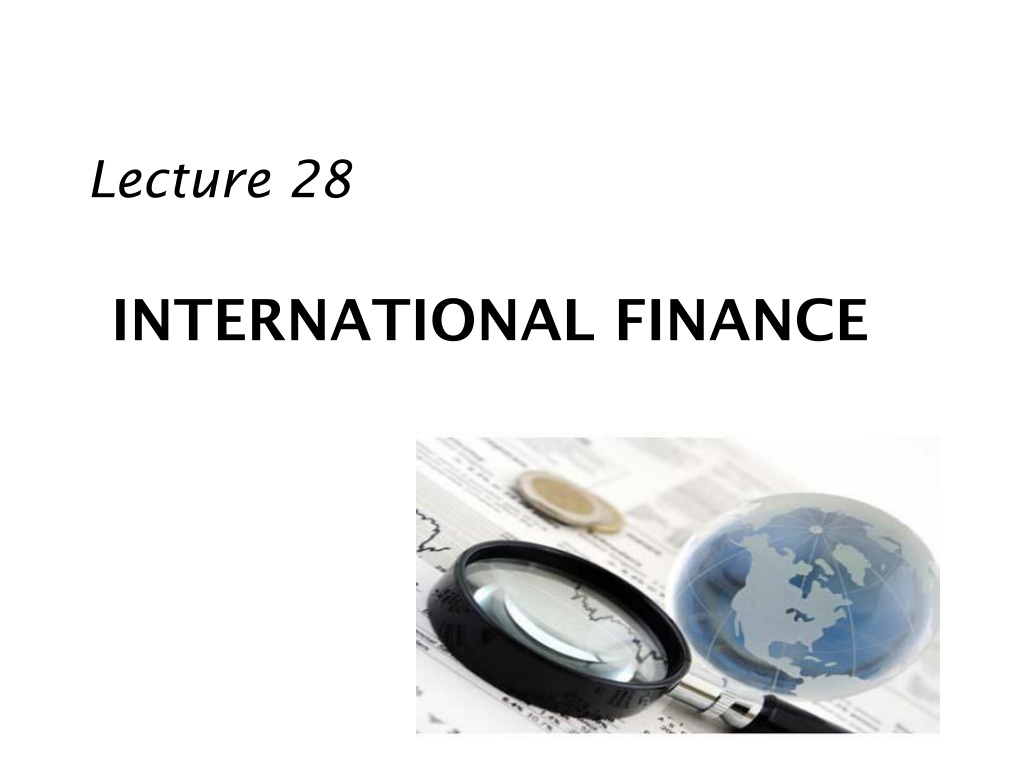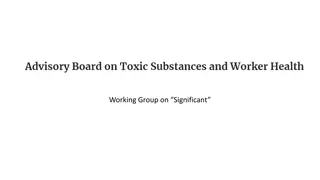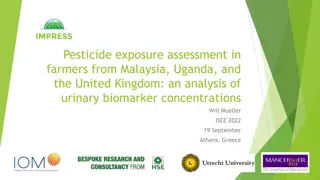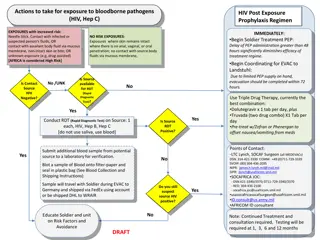Understanding Economic Exposure in International Finance
Explore the concepts of economic exposure and translation exposure in international finance through a case study of Savor Co., a U.S. firm with business units in Europe. Learn how regression analysis is used to assess exposure to currency movements and identify potential hedging strategies to mitigate risks. Dive into the intricacies of managing economic exposure and uncover the sources of Unit C's exposure to the euro.
Download Presentation

Please find below an Image/Link to download the presentation.
The content on the website is provided AS IS for your information and personal use only. It may not be sold, licensed, or shared on other websites without obtaining consent from the author. Download presentation by click this link. If you encounter any issues during the download, it is possible that the publisher has removed the file from their server.
E N D
Presentation Transcript
Lecture 28 INTERNATIONAL FINANCE
Review Economic Exposure with Empirical Analysis An MNC can determine its exposure by assessing the sensitivity MNC can reduce its exposure Restructuring Issues in Restructuring Source: Adopted from South-Western/ Thomson Learning 2006
Lecture 28 MANAGING ECONOMIC EXPOSURE AND TRANSLATION EXPOSURE
Case Study Hedging Economic Exposure Savor Co., a U.S. firm, has three independent units that conduct some business in Europe. It is concerned about its exposure to the euro. To determine whether it is exposed and the source of the exposure, Savor applies a series of regression analysis to its cash flows and the euro s movements.
Case Study Hedging Economic Exposure Assessment of Savor s Exposure: % TotalCashFlowt = a0 + a1% eurot + t The slope coefficient, a1, is found by regression analysis to be positive and statistically significant. Savor is exposed to the euro s movements.
Case Study Hedging Economic Exposure Assessment of Each Unit s Exposure: % UnitCashFlowt = a0 + a1% eurot + t Unit A B C Slope Coefficient Not significant Not significant Statistically significant R-squared Statistic 6.8% 6.7% 93% Unit C is exposed to the euro s movements.
Economic Exposure: Case Study Identifying the Source of Unit C s Exposure: Savor believes that Unit C s cash flows are mainly affected by income statement items. Savor thus applies regression analysis to each income statement item, and finds a significant positive relationship between Unit C s revenue and the euro s value. Savor s economic exposure could be due to foreign competition.
Economic Exposure: Case Study Possible Hedging Strategies: Pricing policy Reduce prices when the euro depreciates. Hedging with forward contracts Sell euros forward to hedge against the adverse effects of a weak euro. Purchasing foreign supplies Costs will be reduced during a weak-euro period.
Economic Exposure: Case Study Possible Hedging Strategies: Financing with foreign funds Costs will be reduced during a weak-euro period. Revising the operations of other units So as to offset the exposure of Unit C.
Hedging Exposure to Fixed Assets When an MNC has fixed assets (such as buildings or machinery) in a foreign country, the cash flows to be received from the sale of these assets is subject to exchange rate risk. A sale of fixed assets can be hedged by creating a liability that matches the expected value of the assets at the point in the future when they will be sold.
Translation Exposure Translation exposure occurs when an MNC translates each subsidiary s financial data to its home currency for consolidated financial statements. Even if translation exposure does not affect cash flows, it is a concern of many MNCs because it can reduce an MNC s consolidated earnings and thereby cause a decline in its stock price. Thus, some MNCs may consider hedging their translation exposure.
Translation Exposure The exposure of an MNC s consolidated financial statements to exchange rate fluctuations is known as translation exposure. In particular, subsidiary earnings translated into the reporting currency on the consolidated income statement are subject to changing exchange rates.
Translation Exposure An MNC creates its financial statements by consolidating all of its individual subsidiaries financial statements. A subsidiary s financial statement is normally measured in its local currency. To be consolidated, each subsidiary s financial statement must be translated into the currency of the MNC s parent. Since exchange rates change over time, the translation of the subsidiary s financial statement into a different currency is affected by exchange rate movements. The exposure of the MNC s consolidated financial statements to exchange rate fluctuations is known as translation exposure.
Determinants of Translation Exposure MNC s degree of translation exposure is dependent on the following: The proportion of its business conducted by foreign subsidiaries The locations of its foreign subsidiaries The accounting methods that it uses
Translation Exposure An MNC s degree of translation exposure is dependent on: the proportion of its business conducted by foreign subsidiaries, the locations of its foreign subsidiaries, and the accounting methods that it uses.
Translation Exposure In the 2000 2001 period, the weakness of the euro caused several U.S.-based MNCs to report lower earnings than what they had expected. In 2002 and 2003, however, the euro strengthened, and the consolidated income statements of these U.S.-based MNCs improved.
Translation Exposure Translation exposure results when an MNC translates each subsidiary s financial data to its home currency for consolidated financial reporting. Translation exposure does not directly affect cash flows, but some firms are concerned about it because of its potential impact on reported consolidated earnings.
Use of Forward Contracts to Hedge Translation Exposure To hedge translation exposure, forward or futures contracts can be used. Specifically, an MNC may sell the currency that its foreign subsidiary receive as earnings forward, thus creating an offsetting cash outflow in that currency.
Use of Forward Contracts to Hedge Translation Exposure Example: A U.S.-based MNC has a British subsidiary. The forecasted British earnings of 20 million (to be entirely reinvested) will be translated at the weighted average value over the year. To hedge this expected earnings, the MNC sells 20 million one year forward. If the depreciates, the gain generated from the forward contract position will help to offset the translation loss.
Limitations of Hedging Translation Exposure 1. Inaccurate earnings forecasts A subsidiary s forecasted earnings for the end of the year are not guaranteed. If the actual earnings turned out to be much higher, and if the currency weakens during the year The translation loss would likely exceed the gain generated from the forward contract strategy.
Limitations of Hedging Translation Exposure 2. Inadequate forward contracts for some currencies A second limitation is that forward contracts are not available for all currencies. Thus, an MNC with subsidiaries in some smaller countries may not be able to obtain forward contracts for the currencies of concern.
Limitations of Hedging Translation Exposure 3. Accounting distortions The forward rate gain or loss reflects the difference between the forward rate and the future spot rate Whereas the translation gain or loss is caused by the change in the average exchange rate over the period in which the earnings are generated. In addition, the translation losses are not tax deductible, whereas gains on forward contracts used to hedge translation exposure are taxed.
Limitations of Hedging Translation Exposure 4. Increased transaction exposure If the foreign currency appreciates during the fiscal year, the transaction loss generated by a forward contract position will somewhat offset the translation gain. The translation gain is simply a paper gain, while the loss resulting from the hedge is a real loss.
Review Economic Exposure through empirical analysis with Significant slope coefficients Possible hedging Restructuring Fixed Assets Translation Exposure Hedging Source: Adopted from South-Western/ Thomson Learning 2006























